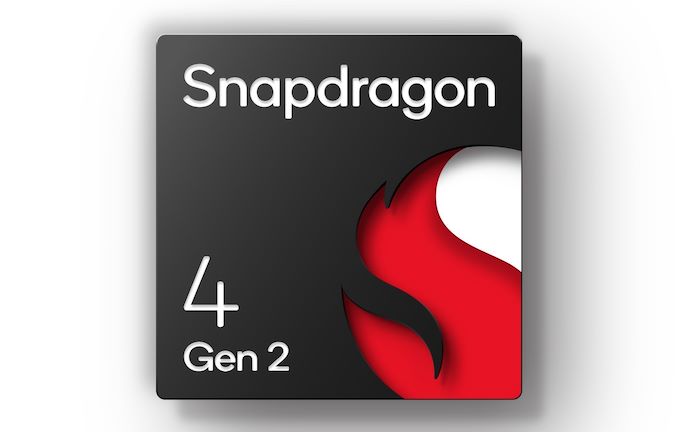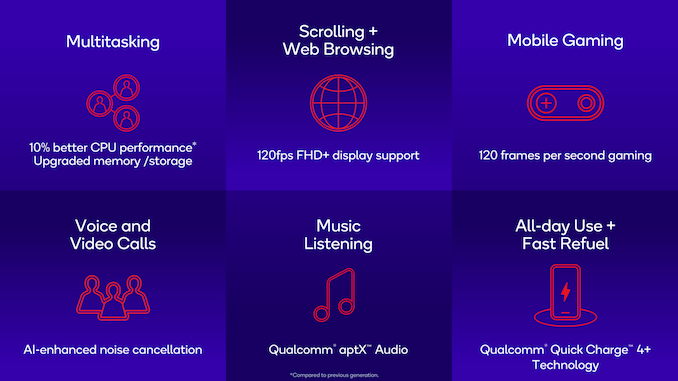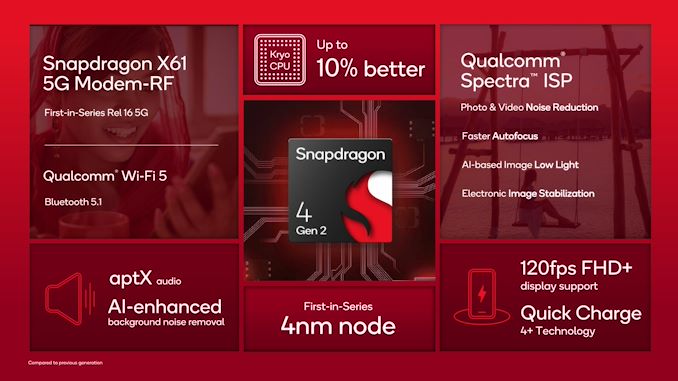Qualcomm Unveils Snapdragon 4 Gen 2: Modest Modernization For Low-End Mobiles
by Ryan Smith on June 26, 2023 11:00 AM EST
Qualcomm this morning is taking the wraps off its next generation Snapdragon 4-class mobile SoC, the aptly named Snapdragon 4 Gen 2. The company’s new entry-level SoC for smartphones and other devices incorporates some hardware updates that should modestly boost performance for the most cost-sensitive segment of the mobile market, as well as bringing Qualcomm’s overall Snapdragon product stack into closer alignment by supporting more recent 5G standards and fabbing the chip to a newer process node.
First and foremost, the top line on performance is that Qualcomm is touting a 10% boost in CPU performance, thanks to higher CPU core clockspeeds. The Snapdragon 4 Gen 2 uses the same 2+6 CPU core configuration as its predecessor, the Snapdragon 4 Gen 1, with 2 Cortex-A78-derived Kryo CPU cores paired with 6 Cortex-A55-derived cores. Thanks to a node shrink, Qualcomm has boosted the top clockspeeds on each set of cores by about 10%, bringing the A78 cores up to 2.2GHz, and the A55 cores up to 2.0GHz. So the 10% CPU performance gain should be fairly consistent in both single and multi-threaded workloads.
Architecturally, there’s little to say about these cores that hasn’t been said already. These are reasonably performant CPU cores, though the age and the lack of higher clockspeeds means their performance potential is limited. The ultra-budget nature of the Snapdragon 4 series means this will be the last part of Qualcomm’s stack to move to any kind of Armv9 core. Though interestingly, the 4 Gen 2 does get a bit of a leg up over the 6 Gen 1 when it comes to the A55 cores – 6G1’s small cores only boost to 1.8GHz, despite being fabbed on the same process node. So this will narrow the CPU performance gap between those parts a bit (at least until the obligatory 6 Gen 2 lands).
Meanwhile, Qualcomm is staying mum on GPU performance. The company stopped giving their GPUs external product numbers a few years ago, and for the Snapdragon 4 release they are not even issuing performance expectations. So we aren’t expecting any gains here, especially as the chip is still meant to drive HD/FHD devices.
| Qualcomm Snapdragon 4-Series SoCs | ||||||
| SoC | Snapdragon 4 Gen 2 (SM4450) |
Snapdragon 4 Gen 1 (SM4375) |
Snapdragon 480 (SM4350) |
|||
| CPU | 2x Cortex-A78 @ 2.2GHz 6x Cortex-A55 @ 2.0GHz |
2x Cortex-A78 @ 2.0GHz 6x Cortex-A55 @ 1.8GHz |
2x Cortex-A76 @ 2.0GHz 6x Cortex-A55 @ 1.8GHz |
|||
| GPU | Adreno | Adreno | Adreno 619 | |||
| DSP | N/A | Hexagon | Hexagon 686 | |||
| ISP/ Camera |
Spectra (2x 12-bit) 1x 108MP or 32MP with ZSL or 16+16MP with ZSL |
Spectra (3x 12-bit) 1x 108MP or 32MP with ZSL or 25+13MP with ZSL or 3x 13MP with ZSL |
Spectra 345 (3x 12-bit) 1x 64MP or 25+13MP or 3x 13MP |
|||
| Encode/ Decode |
1080p60 H.264, H.265, VP9 (Decode-Only) |
|||||
| Memory | 2x 16-bit @ 3200MHz LPDDR5 25.6GB/s or 2x 16-bit @ 2133MHz LPDDR4X 17.0GB/s |
2x 16-bit @ 2133MHz LPDDR4X 17.0GB/s |
2x 16-bit @ 2133MHz LPDDR4X 17.0GB/s |
|||
| Storage | UFS 3.1 (2 lane) | UFS 2.2, eMMC 5.1 | UFS 2.2, eMMC 5.1 | |||
| Integrated Modem | X61 Integrated (Rel. 16) LTE DL = 800Mbps UL = 210Mbps 5G NR Sub-6 (100MHz) DL = 2500Mbps UL = 900Mbps |
X51 Integrated (Rel. 15) LTE DL = 800Mbps UL = 210Mbps 5G NR Sub-6 + mmWave (100MHz) DL = 2500Mbps UL = 900Mbps |
X51 Integrated (Rel. 15) LTE DL = 800Mbps UL = 210Mbps 5G NR Sub-6 + mmWave (100 + 200MHz) DL = 2500Mbps UL = 660Mbps |
|||
| Wi-Fi/BT | Wi-Fi 5 (1x1) Bluetooth 5.1 |
Wi-Fi 5 (2x2) Bluetooth 5.2 |
Wi-Fi 5 (2x2) Bluetooth 5.1 |
|||
| Mfc. Process | Samsung 4nm | TSMC 6nm | Samsung 8nm LPP | |||
As noted earlier, Qualcomm has moved their entry-level SoC to a Samsung 4nm process (given the timing, 4LPP, we’d assume). That means that Samsung’s entire current product stack – Snapdragons 8G2, 7+G2, 6G1, and 4G2 – are all made on a 4nm node of some flavor. Samsung’s is the less performant of the two, but it’s almost certainly cheaper. Which is a boon for these entry-level, price-constrained parts. Academically, I’m curious just how small the Snapdragon 4 die is based on this process, as it should be rather tiny, but that’s not a detail Qualcomm normally shares.
Otherwise, this latest Snapdragon 4-class SoC is a bit of a give-and-take release as compared to the 4 Gen 1. On the memory side of matters, the new SoC incorporates Qualcomm’s newer controller design, bringing LPDDR5 support to a 4-class chip for the first time. Like other Qualcomm SoCs, the chip can run that memory at up to LPDDR5-6400 speeds. Meanwhile, LPDDR4X remains supported as well, at the usual LPDDR4X-4266 data rate. The memory bus is still a total of 32-bits wide, so you’re looking at a peak memory bandwidth of 25.6GB/second with LPDDR5, a full 50% more bandwidth than what the 4 Gen 1 could provide.
The storage controller has also been updated to support UFS 3.1, finally bringing Qualcomm’s low-end chip up to relatively modern version of the flash storage standard. Compared to the UFS 2.2 spec supported in the previous chip, UFS 3.1 a bit more than doubles the bandwidth per lane; so in a two-lane configuration, the 4G2 can theoretically transfer as much as 2.9GB/second of data though Qualcomm isn’t making any performance claims. Notably, eMMC storage support is absent from Qualcomm’s specification sheet, indicating that support for that now well-outdated interface standard is finally riding off into the sunset.
As for Qualcomm’s imaging ISPs and related hardware, the 4 Gen 2 will be taking a step backwards by removing the third camera pipeline. As a result, 4 Gen 2 will only support up to two cameras. The Spectra ISPs themselves are seemingly unchanged, with Qualcomm still using their 12-bit designs. Due to that camera shift, the overall imaging capabilities of the SoC have changed a bit, even in a two camera configuration. The resolutions supported in dual camera zero shutter lag mode are now balanced; rather than 25+13MPixels, the SoC runs at (up to) 16+16Mpixels.
Though with fewer camera modules to support, Qualcomm is touting better camera performance. In particular, Qualcomm says that the new SoC offers faster autofocus support than the 4 Gen 1, as well as an updated electronic image stabilization feature. The 4 Gen 2 also includes an “AI-enhanced” low light feature, and multi-camera temporal filtering (MCTF) support has been baked into the SoC for noise reduction.
Update: And, speaking of AI matters, as we've since learned following Qualcomm's publication of the part's product page, Qualcomm has also removed their venerable Hexagon DSP from this chip. The collection of various acceleration blocks (namely banks of SIMDs) is normally used to efficiently process computer vision, AI, audio, sensor fusion, and other tasks. Depending on the workload, this is either to deliver high raw throughput, or in the case of energy efficiency needs, process a select class of tasks much more efficiently than on the CPU.
Hexagon has been a central part of Snapdragon SoCs since the very first part over 15 years ago, and while the degree to which Qualcomm promotes it varies from generation to generation varies, it's always been there until now. But with a focus on keeping the cost (and die size) of the Snapdragon 4 SoC down, Qualcomm has excised the DSP block and shifted its tasks on to the CPU and the GPU. Ultimately, this doesn't impact the functionality offered by the chip itself (software can always run on the CPU, if the GPU won't do), but it means Qualcomm is drawing from a smaller collection of less specialized hardware for data processing than it has been on previous parts – which means they're likely taking an efficiency hit in the process.
The final major hardware change for the SoC, is an upgrade to a Snapdragon X60-series class modem. New to Qualcomm’s product lineup is the Snapdragon X61 modem, a downscaled version of their X62/X65 modem seem in other chips. Relative to the outgoing 4 Gen 1 SoC and its X51 modem, the X61 supports the newer Release 16 version (aka 5G Phase 2) of the 3GPP standard family.
[image]
Release 16 is now coming up on 3 years old, so this is a needed update to keep up with 5G network development. Though because the primary benefits of Release 16 are more for the network operations side than the consumer side, phone buyers don’t often see much from it besides some improvements in coverage. In the case of the 4 Gen 2, the actual bandwidth figures are unchanged from the 4 Gen 1, which means downloads and uploads top out at 2.5Gbps and 900Mbps respectively.
mmWave support has also remained off of Qualcomm’s spec sheets this time around. On the 4 Gen 1 it ended up being an unlisted feature of sorts – the hardware was there in case any handset vendor wanted to use it, but Qualcomm didn’t advertise it – and it’s unclear whether Qualcomm even bothered with the hardware for this new silicon.
Also of note: Bluetooth 5.2 support has disappeared from Qualcomm’s specifications. Whereas the 4 Gen 1 supported BT 5.2, across Qualcomm's documentation 4 Gen 2 is listed as only supporting BT 5.1. This is notable not only because it’s a regression, but because Bluetooth Low Energy Audio is a 5.2 feature – and arguably the defining feature of 5.2. At this point it’s unclear why Qualcomm would want to remove the feature from their low-end SoC (I suspected royalties, but the LC3 codec for LE Audio is part of the BT license).
The Wi-Fi half of Qualcomm’s radio system has also been downgraded compared to its predecessor. The 4 Gen 2 only supports a single antenna (1x1), whereas previous Snapdragon 4 parts have been 2x2. And even though this is new silicon, the highest supported Wi-Fi standard is still Wi-Fi 5 (802.11ac), so the SoC hasn't improved on what it can do with that single antenna. Suffice it to say, Qualcomm is betting far more heavily on cellular connectivity than Wi-Fi for the kind of emerging and low-cost markets that Snapdragon 4 devices are common in.
Wrapping things up, Qualcomm tells us that several of the usual suspects will be adopting the Snapdragon 4 Gen 2, including Redmi and vivo. Handsets based on the SoC are expected to be announced in the second half of this year.
Source: Qualcomm


















7 Comments
View All Comments
ikjadoon - Monday, June 26, 2023 - link
So much penny pinching on IP. I understand that the $150 to $200 price point is unforgiving, but why did Qualcomm regress? Phones aren’t any cheaper, though the node is cheaper.Sad to see a 2023 SoC w/o Bluetooth LE, WiFi 6, nor AV1 decode.
Glad to see better autofocus than three ISPs, but they’ve not even given a first-party data point to be measured against. Is it 0.05ms faster or 200ms faster? Both could be true!
pugster - Monday, June 26, 2023 - link
Is samsung's 4nm that good compared to TSMC's 6nm?alawadhi3000 - Monday, June 26, 2023 - link
Yes its better than TSMC N6.hemedans - Monday, June 26, 2023 - link
The one used in E1380 and E1330 is really good. Phone with those soc had really good battery life and perfomance was same with Tsmc 6nm.iphonebestgamephone - Wednesday, June 28, 2023 - link
Perf/watt graph from where?Captain obvious - Tuesday, June 27, 2023 - link
As long as clock speeds are around 2ghz, it appears 4lpe/4lpp does fine.For chips trying to boost until 3 GHz, it seems power usage and thermal throttling becomes an issue.